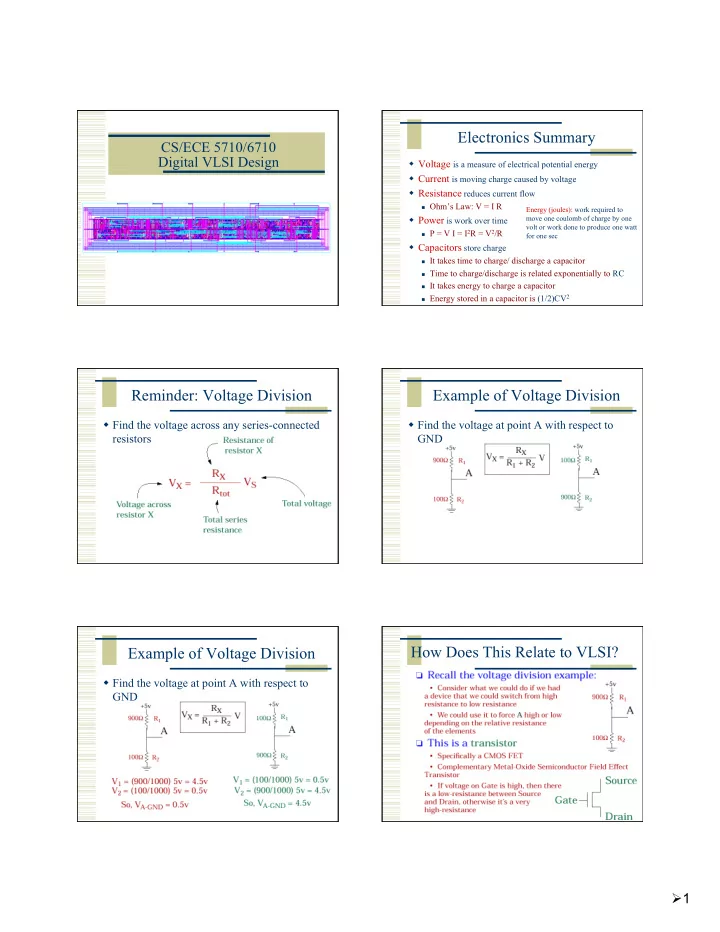

Electronics Summary CS/ECE 5710/6710 Digital VLSI Design Voltage is a measure of electrical potential energy Current is moving charge caused by voltage Resistance reduces current flow Ohm’s Law: V = I R Energy (joules): work required to Power is work over time move one coulomb of charge by one volt or work done to produce one watt P = V I = I 2 R = V 2 /R for one sec Capacitors store charge It takes time to charge/ discharge a capacitor Time to charge/discharge is related exponentially to RC It takes energy to charge a capacitor Energy stored in a capacitor is (1/2)CV 2 Reminder: Voltage Division Example of Voltage Division Find the voltage across any series-connected Find the voltage at point A with respect to resistors GND How Does This Relate to VLSI? Example of Voltage Division Find the voltage at point A with respect to GND 1
Two Types of CMOS Transistors Model of a CMOS Transistor CMOS Transistors Silicon Lattice Transistors are built on a silicon substrate Complementary Metal Oxide Semiconductor Silicon is a Group IV material Two types of transistors Forms crystal lattice with bonds to four Built on silicon substrate neighbors “majority carrier” devices Field-effect transistors An electric field attracts carriers to form a conducting channel in the silicon… We’ll get much more of this later… For now, just some basic abstractions Figures from Reid Harrison “Semi” conductor? “Semi” conductor? Thermal energy (atomic-scale vibrations) can Room temperature: 1.5x10 10 free electrons per cubic centimeter shake an electron loose But, 5x10 22 silicon atoms / cc Leaves a “hole” behind So, one out of every 3 trillion atoms has a missing e Figures from Reid Harrison Figures from Reid Harrison 2
Dopants Dopants Group V: extra electron (n-type) Note that each type of doped silicon is electrostatically neutral in the large Phosphorous, Arsenic, Consists of mobile electrons and holes Group III: missing electron, (p-type) And fixed charges (dopant atoms) Usually Boron Figures from Reid Harrison Figures from Reid Harrison p-n Junctions p-n Junctions A junction between p-type and n-type Two mechanisms for carrier (hole or electron) motion semiconductor forms a diode. Drift - requires an electric field Current flows only in one direction Diffusion – requires a concentration gradient Figures from Reid Harrison p-n Junctions p-n Junctions With no external voltage diffusion causes a Eventually reaches equilibrium where diffusion depletion region current offsets drift current Causes an electric field because of charge recombination Causes drift current… Figures from Reid Harrison Figures from Reid Harrison 3
N-type Transistor p-n Junctions By applying an external voltage you can modulate the width of the depletion region and cause diffusion or drift to dominate… D + G Vds i electrons S - +Vgs Figures from Reid Harrison nMOS Operation nMOS Operation Cont. Body is commonly tied to ground (0 V) When the gate is at a high voltage: When the gate is at a low voltage: Positive charge on gate of MOS capacitor Negative charge attracted to body P-type body is at low voltage Inverts a channel under gate to n-type Source-body and drain-body diodes are OFF Now current can flow through n-type silicon No current flows, transistor is OFF from source through channel to drain, transistor is ON P-type Transistor pMOS Transistor Similar, but doping and voltages reversed Body tied to high voltage (V DD ) Gate low: transistor ON Gate high: transistor OFF Bubble indicates inverted behavior S + -Vgs G Vsd i holes - D 4
A Cutaway View Transistors as Switches CMOS structure with both transistor types For now, we’ll abstract away most analog details… D Good 0 Good 1 G G=0 G=1 S Poor 1 Good 0 S Good 0 Good 1 G G=0 G=1 D Poor 0 Good 1 Not Perfect Switches! “Switching Circuit” “AND” Circuit For example, a switch can control when a Both switch X AND switch Y need to be light comes on or off closed for the light to light up +5v +5v X No electricity can flow Y 0v 0v “OR” Circuit CMOS Inverter The light comes on if either X OR Y are closed +5v X Y 0v 5
CMOS Inverter CMOS Inverter A Y A Y 0 0 1 1 ? CMOS Inverter CMOS Inverter A Y A Y 0 0 1 1 0 1 0 Timing Issues in CMOS Power Consumption 6
CMOS NAND Gate CMOS NAND Gate A B Y 0 0 0 1 1 0 1 1 CMOS NAND Gate CMOS NAND Gate A B Y A B Y 0 0 1 0 0 1 0 1 0 1 1 1 0 1 0 1 1 1 1 CMOS NAND Gate CMOS NAND Gate A B Y A B Y 0 0 1 0 0 1 0 1 1 0 1 1 1 0 1 1 0 1 1 1 1 1 0 7
CMOS NOR Gate 3-input NAND Gate Y pulls low if ALL inputs are 1 Y pulls high if ANY input is 0 3-input NAND Gate N-type and P-type Uses Because of the imperfect nature of the the Y pulls low if ALL inputs are 1 transistor switches Y pulls high if ANY input is 0 ALWAYS use N-type to pull low ALWAYS use P-type to pull high If you need to pull both ways, use them both In S=0, In = Out S S S=1, In = Out Out Switch to Chalkboard Complex Gate Tri-State Latch D-register XOR 8
Recommend
More recommend